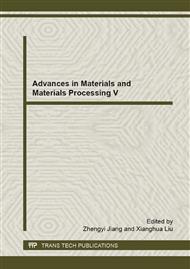p.859
p.865
p.869
p.874
p.879
p.883
p.888
p.894
p.898
The Influence of Metal Surface Roughness on Bonding Strength of Metal and Composite Material
Abstract:
The fiber metal laminates have a wide range of applications today, owing to its high-performance and light weight. However, the interface properties between the fiber face sheet and metal substrate are weak and there are differences in their mechanical properties, causing structural damage or failure. Therefore, this article has come up with a new way to enhance the bonding strength. Through the mechanical methods to get different surfaces, choosing Ra as the evaluating parameter. By conducting the mechanics tests of each specimen, the results showed that with the rising of the Ra, the maximum load of the specimen was rising, too. But the trend wasn’t always the same. After the best Ra, the load declined and kept steady. So, in a small range of roughness, the leading role of bonding strength is the surface of the metal, otherwise, the leading role is the surface of fiber face sheet.
Info:
Periodical:
Pages:
879-882
Citation:
Online since:
March 2015
Authors:
Keywords:
Price:
Сopyright:
© 2015 Trans Tech Publications Ltd. All Rights Reserved
Share:
Citation:


